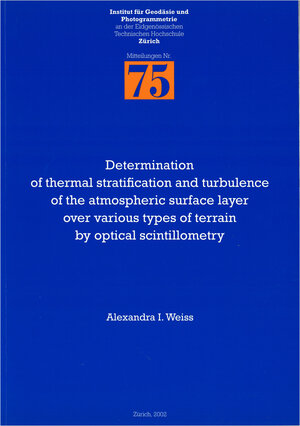
×
![Buchcover ISBN 9783906467368]()
Determination of thermal stratification and turbulence of the atmospheric surface layer over various types of terrain by optical scintillometry
von Alexandra I Weiss, Vorwort von Hilmar IngensandThermal stratification and turbulence in the atmospheric surface layer cause refraction and scintillation of an optical beam. On the one hand, such atmospherically induced effects are undesirable in many applications which are based on optical wave propagation through the atmospheric boundary layer. Such examples are found in many applications of terrestrial optical surveying. On the other hand, such atmospherically induced effects can be used to derive various meteorological parameters. Based on these consideration the present work deals with the determination of thermal stratification and turbulence of the atmospheric surface layer over different types of terrain by optical scintillometry.
First, in this study a method is introduced and experimentally verified to derive correction values for precise terrestrial geodetic measurements. For highly precise optical direction and distance measurements, such corrections require line-averaged temperature or refractive index gradients. Secondly, this study investigates how precisely line-averaged turbulence parameters can be derived in the atmospheric surface layer by scintillometry and whether their derivation deepens our understanding of the structure of the atmospheric surface layer, especially over non-homogeneous terrain. Here, the main focus lies in the investigation of the accuracy of the turbulent sensible heat and momentum fluxes, and the dissipation rate of turbulent kinetic energy, which are of grave importance for many meteorological applications. This work is based on various field experiments conducted with a so-called displaced-beam scintillometer under different atmospheric conditions. The experimental sites varied from homogeneous and flat terrain to flat, non-homogeneous terrain up to slanted, non-homogeneous terrain in an alpine valley. For validation of the method, additional meteorological measurement techniques are used and are considered in the data analysis, such as eddy-correlation measurements with sonic anemometer-thermometers and Krypton hygrometers, and temperature profile measurements with Pt-1000 sensors.
The derivation of the thermal stratification from the scintillation method is especially dependent on the accuracy of the derived turbulent sensible heat flux. In the scope of this study, satisfactory accuracy of the derived turbulent sensible heat fluxes is obtained, even for non-homogeneous terrain. It is shown that the presented method is applicable for deriving line-averaged refraction correction values over various types of terrain and for different atmospheric conditions with a good temporal resolution. This result is confirmed by comparisons with local temperature profile measurements. The limitations of this method are discussed on the basis of the experimental data-sets. For instance, under neutral conditions, with weak thermal turbulence, the derivation of accurate values of the turbulent momentum flux can be problematic with this method. However, in this work it is shown that the scintillation method gives accurate values under many atmospheric conditions including the turbulent momentum flux and for several other turbulence parameters. On the basis of the field experiments, new insights into the turbulence structure of the surface layer can be achieved by scintillometry, even over non-homogeneous terrain. In this context the turbulent structure in an alpine valley is analysed and described under various boundary layer features.
First, in this study a method is introduced and experimentally verified to derive correction values for precise terrestrial geodetic measurements. For highly precise optical direction and distance measurements, such corrections require line-averaged temperature or refractive index gradients. Secondly, this study investigates how precisely line-averaged turbulence parameters can be derived in the atmospheric surface layer by scintillometry and whether their derivation deepens our understanding of the structure of the atmospheric surface layer, especially over non-homogeneous terrain. Here, the main focus lies in the investigation of the accuracy of the turbulent sensible heat and momentum fluxes, and the dissipation rate of turbulent kinetic energy, which are of grave importance for many meteorological applications. This work is based on various field experiments conducted with a so-called displaced-beam scintillometer under different atmospheric conditions. The experimental sites varied from homogeneous and flat terrain to flat, non-homogeneous terrain up to slanted, non-homogeneous terrain in an alpine valley. For validation of the method, additional meteorological measurement techniques are used and are considered in the data analysis, such as eddy-correlation measurements with sonic anemometer-thermometers and Krypton hygrometers, and temperature profile measurements with Pt-1000 sensors.
The derivation of the thermal stratification from the scintillation method is especially dependent on the accuracy of the derived turbulent sensible heat flux. In the scope of this study, satisfactory accuracy of the derived turbulent sensible heat fluxes is obtained, even for non-homogeneous terrain. It is shown that the presented method is applicable for deriving line-averaged refraction correction values over various types of terrain and for different atmospheric conditions with a good temporal resolution. This result is confirmed by comparisons with local temperature profile measurements. The limitations of this method are discussed on the basis of the experimental data-sets. For instance, under neutral conditions, with weak thermal turbulence, the derivation of accurate values of the turbulent momentum flux can be problematic with this method. However, in this work it is shown that the scintillation method gives accurate values under many atmospheric conditions including the turbulent momentum flux and for several other turbulence parameters. On the basis of the field experiments, new insights into the turbulence structure of the surface layer can be achieved by scintillometry, even over non-homogeneous terrain. In this context the turbulent structure in an alpine valley is analysed and described under various boundary layer features.


